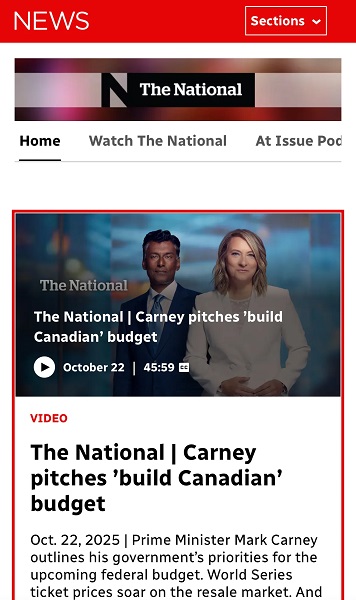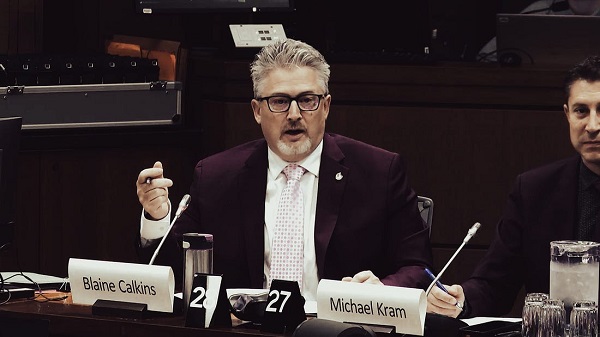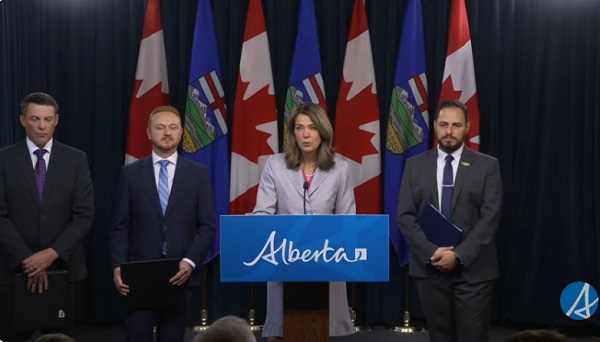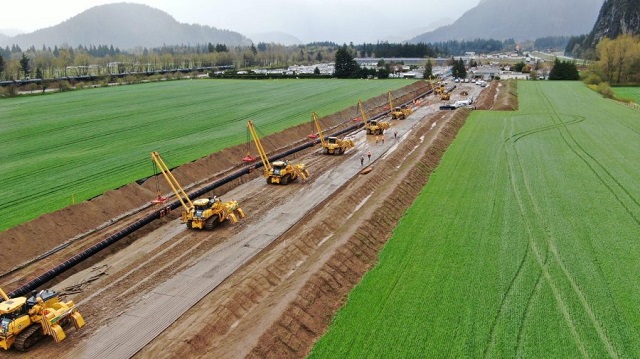Energy
Judge grants motion by state of Michigan to appeal key decision in Line 5 dispute
By James McCarten in Washington
The U.S. judge presiding over Michigan’s bid to shut down the Line 5 pipeline has given her blessing to the state to appeal one of her key findings, breathing new life into a strategy that hinges on getting the dispute heard by a lower court.
Back in August, District Court Judge Janet Neff rejected a motion from Michigan Attorney General Dana Nessel to send the case back to state court, where Nessel has acknowledged they have a better chance of winning.
But earlier this week, Neff granted Nessel’s request to certify that August decision, clearing the way for what’s known as an interlocutory appeal — formally asking an appeals court to reverse a judge’s order before a final decision in the case has been made.
Such certifications, rare in U.S. law, must meet certain conditions, Neff wrote in a decision Tuesday: that they involve a “controlling question of law” that’s likely to generate a difference of opinion, and that an appeal could expedite a resolution.
“Having reviewed the record, the court concludes that this dispute is one of the exceptional situations that compels certification,” the order reads.
“Each of the three issues identified by (the) plaintiff involve a controlling question of law, there is substantial ground for difference of opinion, and an immediate appeal will materially advance the ultimate termination of the litigation.”
Neff has also ordered that the current case — just one of several open files involving Enbridge Inc., Line 5 and the state of Michigan — remain stayed and administratively closed until the appeal is resolved.
Michigan has been in court for years with Calgary-based Enbridge in an effort to shut down Line 5, fearing a disaster in the Straits of Mackinac, the ecologically sensitive region where the pipeline crosses the Great Lakes.
Enbridge and its allies, which include the federal Liberal government in Ottawa, insist the pipeline is safe, that planned upgrades will make it even safer, and that a shutdown would impart too great a cost for the North American economy to bear.
The legal saga, however, has been dominated almost from the start by arcane procedural questions about jurisdiction and precedent, with Tuesday’s decision likely to deepen that morass even more.
Nessel has made three central arguments: that Enbridge flouted a 30-day window to move the case to district court; that Neff relied too heavily on her own earlier decision to reject Nessel’s motion in a separate but nearly identical Line 5 case; and that the question of jurisdiction has not been properly settled.
“The attorney general believes that the federal trial court clearly erred when it refused to send the case back to state court,” Nessel’s office said in a statement. “The order allows (Nessel) to ask the federal court of appeals to step in and right this wrong.”
Environmental groups in Michigan that back the state’s efforts against Line 5 also cheered the decision.
“This ruling is good news for the Great Lakes. Enbridge’s use of the federal courts to delay the state’s ability to protect the Great Lakes is unconscionable,” National Wildlife Federation counsel Andy Buchsbaum said in a statement.
“We hope that this will get the case back on track quickly so the Great Lakes doesn’t suffer from a massive oil spill.”
Enbridge, for its part, sees things differently.
A statement from the company cited Neff’s own words from the August 2022 decision in which she accused Nessel of seeking “a race to judgment and a collision course between the state and federal forum.”
“The attorney general seeks to undermine these considerations and promote gamesmanship and forum shopping,” Enbridge said, “while ignoring the substantial federal issues that are properly decided in federal court and not state court.”
This report by The Canadian Press was first published Feb. 23, 2023.
Alberta
Nobel Prize nods to Alberta innovation in carbon capture

From the Canadian Energy Centre
‘We are excited to bring this made-in-Canada innovation to the world’
To the naked eye, it looks about as exciting as baking soda or table salt.
But to the scientists in the University of Calgary chemistry lab who have spent more than a decade working on it, this white powder is nothing short of amazing.
That’s because the material they invented is garnering global attention as a new solution to help address climate change.
Known as Calgary Framework-20 (CALF-20 for short), it has “an exceptional capacity to absorb carbon dioxide” and was recognized in connection with the 2025 Nobel Prize in Chemistry.
“It’s basically a molecular sponge that can adsorb CO2 very efficiently,” said Dr. George Shimizu, a UCalgary chemistry professor who leads the research group that first developed CALF-20 in 2013.
The team has been refining its effectiveness ever since.
“CALF-20 is a very exciting compound to work on because it has been a great example of translating basic science into something that works to solve a problem in the real world,” Shimizu said.
Advancing CCS
Carbon capture and storage (CCS) is not a new science in Alberta. Since 2015, operating projects in the province have removed 15 million tonnes of CO2 that would have otherwise been emitted to the atmosphere.
Alberta has nearly 60 proposed facilities for new CCS networks including the Pathways oil sands project, according to the Regina-based International CCS Knowledge Centre.
This year’s Nobel Prize in Chemistry went to three of Shimizu’s colleagues in Japan, Australia and the United States, for developing the earliest versions of materials like CALF-20 between 1989 and 2003.
Custom-built molecules
CALF-20 is in a class called metal-organic frameworks (MOFs) — custom-built molecules that are particularly good at capturing and storing specific substances.
MOFs are leading to new technologies for harvesting water from air in the desert, storing toxic gases, and capturing CO2 from industrial exhaust or directly from the atmosphere.
CALF-20 is one of the few MOF compounds that has advanced to commercial use.
“There has been so much discussion about all the possible uses of MOFs, but there has been a lot of hype versus reality, and CALF-20 is the first to be proven stable and effective enough to be used at an industrial scale,” Shimizu said.
It has been licensed to companies capturing carbon across a range of industries, with the raw material now being produced by the tonne by chemical giant BASF.
Carbon capture filter gigafactory
Svante Inc. has demonstrated its CALF-20-based carbon capture system at a cement plant in British Columbia.
The company recently opened a “gigafactory” in Burnaby equipped to manufacture enough carbon capture and removal filters for up to 10 million tonnes of CO2 annually, equivalent to the emissions of more than 2.3 million cars.
The filters are designed to trap CO2 directly from industrial emissions and the atmosphere, the company says.
Svante chief operating officer Richard Laliberté called the Nobel committee’s recognition “a profound validation” for the entire field of carbon capture and removal.
CALF-20 expansion
Meanwhile, one of Shimizu’s former PhD students helped launch a spinoff company, Existent Sorbents, to further expand the applications of CALF-20.
Existent is working with oil sands producers, a major steel factory and a U.S.-based firm capturing emissions from other point sources, said CEO Adrien Côté.
“The first users of CALF-20 are leaders who took the risk of introducing new technology to industries that are shrewd about their top and bottom lines,” Côté said.
“It has been a long journey, but we are at the point where CALF-20 has proven to be resilient and able to survive in harsh real-world conditions, and we are excited to bring this made-in-Canada innovation to the world.”
Business
Bill Gates walks away from the climate cult

Billionaire Bill Gates — long one of the loudest voices warning of climate catastrophe — now says the world has bigger problems to worry about. In a 17-page memo released Tuesday, the Microsoft co-founder called for a “strategic pivot” away from the obsessive focus on reducing global temperatures, urging leaders instead to prioritize fighting poverty and eradicating disease in the developing world. “Climate change is a serious problem, but it’s not the end of humanity,” Gates wrote.
Gates, 70, argued that global leaders have lost perspective by treating climate change as an existential crisis while millions continue to suffer from preventable diseases like malaria. “If I had to choose between eradicating malaria and preventing a tenth of a degree of warming, I’d let the temperature go up 0.1 degree,” he told reporters ahead of next month’s U.N. climate conference in Brazil. “People don’t understand the suffering that exists today.”
For decades, Gates has positioned himself as a leading advocate for global climate initiatives, investing billions in green energy projects and warning of the dangers of rising emissions. Yet his latest comments mark a striking reversal — and a rare admission that the world’s climate panic may have gone too far. “If you think climate is not important, you won’t agree with the memo,” Gates told journalists. “If you think climate is the only cause and apocalyptic, you won’t agree with the memo. It’s a pragmatic view from someone trying to maximize the money and innovation that helps poor countries.”
The billionaire’s change in tone is sure to raise eyebrows ahead of the U.N. conference, where climate activists plan to push for new emissions targets and wealth transfers from developed nations. Critics have long accused Gates and other elites of hypocrisy for lecturing the public about fossil fuels while traveling the globe on private jets. Now, Gates himself appears to be distancing from the doomsday rhetoric he once helped spread, effectively admitting that humanity faces more immediate moral imperatives than the weather.
(AP Photo/Alex Brandon)
Stunning Climate Change pivot from Bill Gates. Poverty and disease should be top concern.
-

 Alberta1 day ago
Alberta1 day agoFrom Underdog to Top Broodmare
-

 Media23 hours ago
Media23 hours agoCarney speech highlights how easily newsrooms are played by politicians
-

 Business1 day ago
Business1 day agoThe painful return of food inflation exposes Canada’s trade failures
-

 Business5 hours ago
Business5 hours agoPaying for Trudeau’s EV Gamble: Ottawa Bought Jobs That Disappeared
-

 Business8 hours ago
Business8 hours agoCBC uses tax dollars to hire more bureaucrats, fewer journalists
-

 National6 hours ago
National6 hours agoElection Officials Warn MPs: Canada’s Ballot System Is Being Exploited
-

 International2 days ago
International2 days agoPrince Andrew banished from the British monarchy
-

 Business2 days ago
Business2 days ago“We have a deal”: Trump, Xi strike breakthrough on trade and fentanyl







